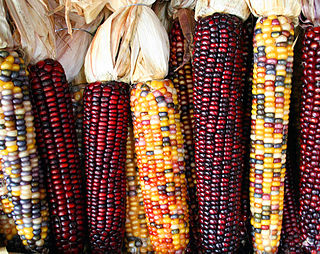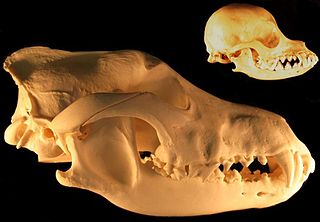Related Research Articles

Zea is a genus of flowering plants in the grass family. The best-known species is Z. mays, one of the most important crops for human societies throughout much of the world. The four wild species are commonly known as teosintes and are native to Mesoamerica.

Domestication is a multi-generational mutualistic relationship in which an animal species, such as humans or leafcutter ants, takes over control and care of another species, such as sheep or fungi, to obtain from them a steady supply of resources, such as meat, milk, or labor. The process is gradual and geographically diffuse, based on trial and error.

A population bottleneck or genetic bottleneck is a sharp reduction in the size of a population due to environmental events such as famines, earthquakes, floods, fires, disease, and droughts; or human activities such as genocide, speciocide, widespread violence or intentional culling. Such events can reduce the variation in the gene pool of a population; thereafter, a smaller population, with a smaller genetic diversity, remains to pass on genes to future generations of offspring. Genetic diversity remains lower, increasing only when gene flow from another population occurs or very slowly increasing with time as random mutations occur. This results in a reduction in the robustness of the population and in its ability to adapt to and survive selecting environmental changes, such as climate change or a shift in available resources. Alternatively, if survivors of the bottleneck are the individuals with the greatest genetic fitness, the frequency of the fitter genes within the gene pool is increased, while the pool itself is reduced.
Population genetics is a subfield of genetics that deals with genetic differences within and among populations, and is a part of evolutionary biology. Studies in this branch of biology examine such phenomena as adaptation, speciation, and population structure.
Archaeogenetics is the study of ancient DNA using various molecular genetic methods and DNA resources. This form of genetic analysis can be applied to human, animal, and plant specimens. Ancient DNA can be extracted from various fossilized specimens including bones, eggshells, and artificially preserved tissues in human and animal specimens. In plants, ancient DNA can be extracted from seeds and tissue. Archaeogenetics provides us with genetic evidence of ancient population group migrations, domestication events, and plant and animal evolution. The ancient DNA cross referenced with the DNA of relative modern genetic populations allows researchers to run comparison studies that provide a more complete analysis when ancient DNA is compromised.

George Wells Beadle was an American geneticist. In 1958 he shared one-half of the Nobel Prize in Physiology or Medicine with Edward Tatum for their discovery of the role of genes in regulating biochemical events within cells. He also served as the 7th President of the University of Chicago.

Tehuacán is the second largest city in the Mexican state of Puebla, nestled in the southeast of the valley of Tehuacán, bordering the states of Oaxaca and Veracruz. The 2010 census reported a population of 248,716 in the city and 274,906 in the surrounding Tehuacán municipality, of which it serves as municipal seat. The municipality has an area of 390.36 km2 (150.72 sq mi).

The domestication of vertebrates is the mutual relationship between vertebrate animals including birds and mammals, and the humans who have influence on their care and reproduction.
Meiotic drive is a type of intragenomic conflict, whereby one or more loci within a genome will affect a manipulation of the meiotic process in such a way as to favor the transmission of one or more alleles over another, regardless of its phenotypic expression. More simply, meiotic drive is when one copy of a gene is passed on to offspring more than the expected 50% of the time. According to Buckler et al., "Meiotic drive is the subversion of meiosis so that particular genes are preferentially transmitted to the progeny. Meiotic drive generally causes the preferential segregation of small regions of the genome".
In genetics, a selective sweep is the process through which a new beneficial mutation that increases its frequency and becomes fixed in the population leads to the reduction or elimination of genetic variation among nucleotide sequences that are near the mutation. In selective sweep, positive selection causes the new mutation to reach fixation so quickly that linked alleles can "hitchhike" and also become fixed.
Jeffrey Lynn Bennetzen is an American geneticist on the faculty of the University of Georgia (UGA). Bennetzen is known for his work describing codon usage bias in yeast, and E. coli; being the first to clone and sequence an active transposon in plants, discovering that most of the DNA in plant genomes was a particular class of mobile DNA (LTR-retrotransposons); solving the C-value paradox; proposing sorghum and Setaria as model grasses; showing that rice centromeres were hotspots for recombination, but not crossovers; and developing a technique to date polyploidization events. He is an author, with Sarah Hake of the book "Handbook of Maize." Bennetzen was elected to the US National Academy of Sciences in 2004.
Evolutionary developmental biology (evo-devo) is the study of developmental programs and patterns from an evolutionary perspective. It seeks to understand the various influences shaping the form and nature of life on the planet. Evo-devo arose as a separate branch of science rather recently. An early sign of this occurred in 1999.

Maize, also known as corn in North American English, is a tall stout grass that produces cereal grain. It was domesticated by indigenous peoples in southern Mexico about 9,000 years ago from wild teosinte. Native Americans planted it alongside beans and squashes in the Three Sisters polyculture. The leafy stalk of the plant gives rise to male inflorescences or tassels which produce pollen, and female inflorescences called ears. The ears yield grain, known as kernels or seeds. In modern commercial varieties, these are usually yellow or white; other varieties can be of many colors.

The Balsas River is a major river of south-central Mexico.
In molecular biology, the protein domain TCP is actually a family of transcription factors named after: teosinte branched 1, cycloidea (cyc) and PCF in rice.

Guilá Naquitz Cave in Oaxaca, Mexico, is the site of early domestication of several food crops, including teosinte, squash from the genus Cucurbita, bottle gourds, and beans. This site is the location of the earliest known evidence for domestication of any crop on the continent, Cucurbita pepo, as well as the earliest known domestication of maize.

Domestication syndrome refers to two sets of phenotypic traits that are common to either domesticated plants or domesticated animals.
hAT transposons are a superfamily of DNA transposons, or Class II transposable elements, that are common in the genomes of plants, animals, and fungi.
The agricultural weed syndrome is the set of common traits which make a plant a successful agricultural weed. Most of these traits are not, themselves, phenotypes but are instead methods of rapid adaptation. So equipped, plants of various origins - invasives, natives, mildly successful marginal weeds of agriculture, weeds of other settings - accumulate other characteristics which allow them to compete in an environment with a high degree of human management.
Brandon Stuart Gaut is an American evolutionary biologist and geneticist who works as a Distinguished Professor of Ecology and Evolutionary Biology at the University of California, Irvine.
References
- ↑ Brownlee, C. (2004). "Biography of John F. Doebley". Proceedings of the National Academy of Sciences. 101 (3): 697–699. doi: 10.1073/pnas.0308650101 . PMC 321742 . PMID 14718662.
- ↑ Michael Balter, Corn: It's Not for Cocktails. 23 March 2009 news.sciencemag.org
- ↑ Matsuoka, Y.; Vigouroux, Y; Goodman, MM; et al. (2002). "A single domestication for maize shown by multilocus microsatellite genotyping". Proceedings of the National Academy of Sciences. 99 (9): 6080–4. Bibcode:2002PNAS...99.6080M. doi: 10.1073/pnas.052125199 . PMC 122905 . PMID 11983901.
- ↑ Doebley, J.; Stec, A.; Gustus, C. (1995). "Teosinte branched1 and the origin of maize: Evidence for epistasis and the evolution of dominance". Genetics. 141 (1): 333–346. doi:10.1093/genetics/141.1.333. PMC 1206731 . PMID 8536981.
- ↑ Doebley, J.; Stec, A.; Hubbard, L. (1997). "The evolution of apical dominance in maize". Nature. 386 (6624): 485–488. Bibcode:1997Natur.386..485D. doi:10.1038/386485a0. PMID 9087405. S2CID 4360859.
- ↑ Wang, H.; Nussbaum-Wagler, T.; Li, B.; Zhao, Q.; Vigouroux, Y.; Faller, M.; Bomblies, K.; Lukens, L.; Doebley, J. F. (2005). "The origin of the naked grains of maize". Nature. 436 (7051): 714–719. Bibcode:2005Natur.436..714W. doi:10.1038/nature03863. PMC 1464477 . PMID 16079849.
- ↑ "News and Events".
- ↑ "John Doebley named new chair of Genetics – eCALS".